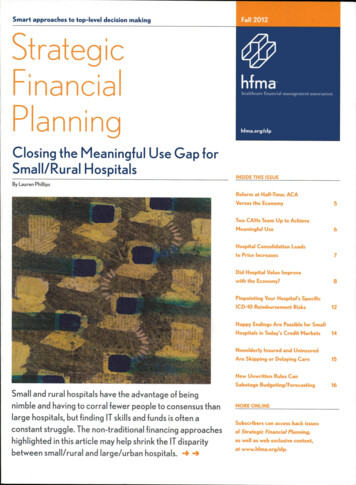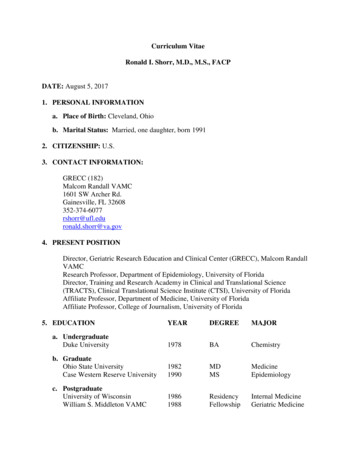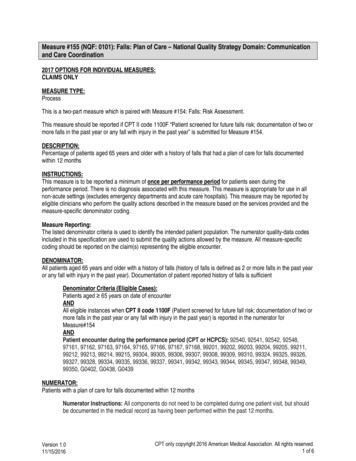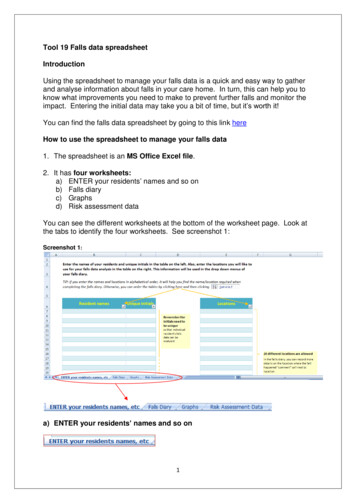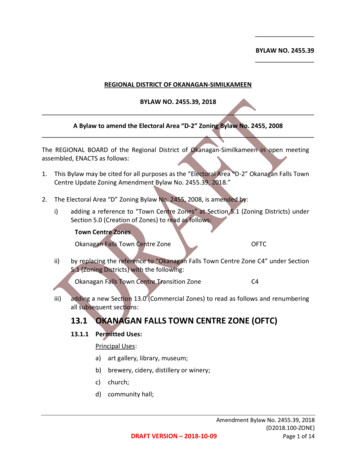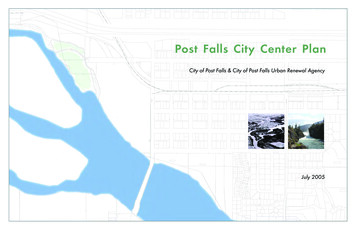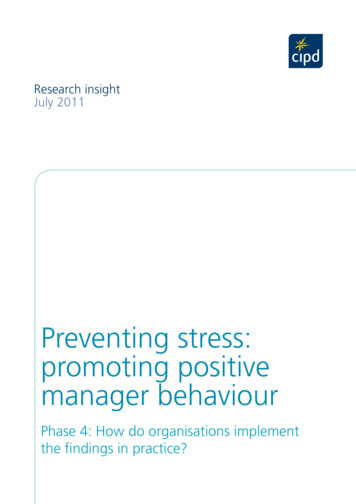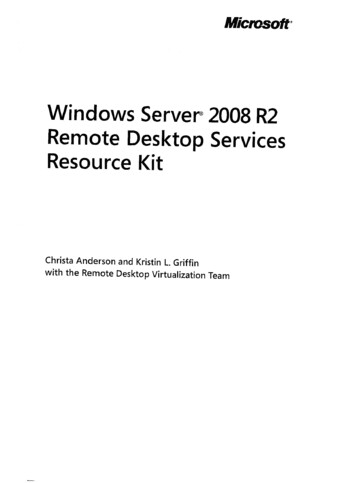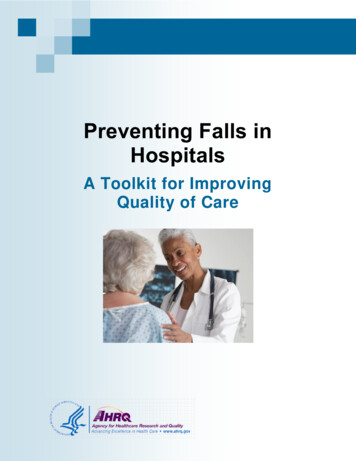
Transcription
Preventing Falls inHospitalsA Toolkit for ImprovingQuality of Care
The information in this toolkit is intended to assist service providersand hospitals in developing falls prevention protocols. This toolkit isintended as a reference and not as a substitute for professionaljudgment. The opinions expressed in this document are those of theauthors and do not necessarily reflect the views of AHRQ. Nostatement in this toolkit should be construed as an official position ofAHRQ or the U.S. Department of Health and Human Services. Inaddition, AHRQ or U.S. Department of Health and Human Servicesendorsement of any derivative product may not be stated or implied.
Preventing Falls in HospitalsA Toolkit for Improving Quality of CarePrepared for:Agency for Healthcare Research and Quality540 Gaither RoadRockville, MD 20850www.ahrq.govPrepared by:RAND CorporationBoston University School of Public HealthECRI InstituteContract No. HHSA290201000017I TO #1AHRQ Publication No. 13-0015-EFJanuary 2013
AuthorsRAND CorporationDavid A. Ganz, M.D., Ph.D., VA Greater Los Angeles Healthcare System, University ofCalifornia at Los Angeles, and RAND CorporationChristina Huang, M.P.H., RAND CorporationDebra Saliba, M.D., M.P.H., VA Greater Los Angeles Healthcare System, UCLA/JH BorunCenter for Gerontological Research, and RAND CorporationVictoria Shier, M.P.A., RAND CorporationBoston University School of Public HealthDan Berlowitz, M.D., M.P.H., Bedford VA Hospital and Boston University School of PublicHealthCarol VanDeusen Lukas, Ed.D., VA Boston Healthcare System and Boston University School ofPublic HealthECRI InstituteKathryn Pelczarski, B.S.Karen Schoelles, M.D., S.M.Linda C. Wallace, M.S.N., B.S.N.Patricia Neumann, R.N., M.S.This document is in the public domain and may be used and reprinted without specialpermission. Citation of the source is appreciated.Suggested citation:Ganz DA, Huang C, Saliba D, et al. Preventing falls in hospitals: a toolkit for improving qualityof care. (Prepared by RAND Corporation, Boston University School of Public Health, and ECRIInstitute under Contract No. HHSA290201000017I TO #1.) Rockville, MD: Agency forHealthcare Research and Quality; January 2013. AHRQ Publication No. 13-0015-EF.ii
ContentsRoadmap .vAcknowledgments. ixOverview .1The Problem of Falls .1The Challenges of Fall Prevention .1Toolkit Designed for Multiple Audiences .2Implementation Guide Organized To Direct Hospitals Through the Change Process .3Sections of the Guide .3Adaptation of the Guide to Your Organization.3Improvement as Puzzle Pieces .4Icons .51. Are you ready for this change? .61.1. Do organizational members understand why change is needed?.61.2. Is there urgency to change?.81.3. Does senior administrative leadership support this program? .91.4. Who will take ownership of this effort? .111.5. What kinds of resources are needed? .121.6. What if you are not ready for full-scale change? .121.7. Checklist for assessing readiness for change .132. How will you manage change? .142.1. How can you set up the Implementation Team for success? .152.2. What needs to change and how do you need to redesign it? .192.3. How should goals and plans for change be developed? .252.4. Checklist for managing change .263. Which fall prevention practices do you want to use? .273.1. Which fall prevention practices should you use? .283.2. What are universal fall precautions and how should they be implemented? .303.3. What is a standardized assessment of risk factors for falls, and how should thisassessment be conducted? .343.4. How should identified risk factors be used for fall prevention care planning? .383.5. How should you assess and manage patients after a fall? .463.6. How can your hospital incorporate these practices into a fall prevention program? .493.7. What additional resources are available to identify best practices for fall prevention? .513.8. Checklist for best practices .514. How do you implement the fall prevention program in your organization? .524.1. What roles and responsibilities will staff have in preventing falls? .534.2. What fall prevention practices go beyond the unit?.594.3. How do you put the new practices into operation? .604.4. Checklist for implementing best practices .675. How do you measure fall rates and fall prevention practices? .685.1. How do you measure fall and fall-related injury rates? .695.2. How do you measure fall prevention practices? .775.3. Checklist for measuring progress.80iii
6. How do you sustain an effective fall prevention program? .816.1. Who will be responsible for sustaining active fall prevention efforts onan ongoing basis? .826.2. How will you continue to monitor fall rates and fall prevention care processes? .826.3. What types of ongoing organizational support do you need to keep the newpractices in place? .836.4. How can you reinforce the desired results? .846.5. Summary .877. Tools and Resources .89Appendix: Bibliography of Studies Implementing Fall Prevention Practices .185iv
RoadmapWho Should Use TheToolSectionAction StepsTool That Supports ActionOverviewEnlist support of senior leadersTool ØA, Introduction and Overview forStakeholdersSenior managerSection 1Are you ready for this change?1.1Assess the culture of safety in yourhospitalTool 1A, Hospital Survey on Patient Safety CultureAll interdisciplinaryteam members1.2Evaluate current organizationalattention to fallsTool 1B, Stakeholder AnalysisImplementation Teamleader1.3Assess and develop leadershipsupport for the fall preventionprogramTool 1C, Leadership Support AssessmentImplementation Teamleader1.5Identify resources that are availableand resources that are neededTool 1E, Resource Needs AssessmentImplementation Teamleader1.7Assess your progress on completingreadiness for change activitiesTool 1F, Organizational Readiness ChecklistImplementation TeamleaderSection 2How will you manage change?2.1Identify your Implementation TeamTool 2A, Interdisciplinary TeamImplementation Teamleader2.2Assess the current status of fallprevention activities in yourhospitalTool 2B, Quality Improvement ProcessImplementation Teamleader, individualsdesignated by theTool 1D, Business Case FormTool 2C, Current Process Analysisv
Tool 2D, Assessing Current Fall Prevention Policiesand PracticesImplementation TeamleaderDetermine staff knowledge aboutfall preventionTool 2E, Fall Knowledge TestStaff nurses andnursing assistants2.3Set goals for improvement based onoutcomes and processesTool 2F, Action PlanImplementation Teamleader with qualityimprovement/safety/risk managerSectionAction StepsTool That Supports Action2.4Assess your progress on completingthe managing change activitiesTool 2G, Managing Change ChecklistSection 3Which fall prevention practices do you want to use?3.1Identify how fall prevention careprocesses connect to one anotherTool 3A, Master Clinical Pathway for Inpatient FallsQualityimprovement/safety/risk manager, staffnurses, nursingassistants3.2Implement universal fallprecautionsTool 3B, Scheduled Rounding ProtocolUnit manager, staffnurses, nursingassistants, facilityengineer, hospitalemployee who enterspatient roomsTool 3C, Tool Covering Environmental Safety at theBedsideTool 3D, Hazard Report FormTool 3E, Clinical Pathway for Safe Patient HandlingviWho should use thetoolImplementation Teamleader
3.3Identify important risk factors forfalls in your patientsTool 3F, Orthostatic Vital Sign MeasurementTool 3G, STRATIFY Scale for Identifying Fall RiskFactorsStaff nurses,pharmacist, nursingassistantsTool 3H, Morse Fall Scale for Identifying Fall RiskFactorsTool 3I, Medication Fall Risk Scale and EvaluationTools3.4Use identified fall risk factors toimplement fall prevention careplanningTool 3J, Delirium Evaluation Bundle: Digit Span,Short Portable Mental Status Questionnaire, andConfusion Assessment MethodTool 3K, Algorithm for Mobilizing PatientsEducators, staff nurses,physicians, nursepractitioners, physicianassistants, nursingassistantsTool 3L, Patient and Family EducationTool 3M, Sample Care Plan3.5Assess and manage patients after afallTool 3N, Postfall Assessment, Clinical ReviewStaff nurses andphysiciansTool 3O, Postfall Assessment for Root CauseAnalysisSectionAction StepsTool That Supports Action3.8Assess your progress on completingthe best practices activitiesTool 3P, Best Practices ChecklistSection 4How do you implement the fall prevention program in your organization?viiWho should use thetoolImplementation TeamLeader
4.1Assign staff roles andresponsibilities for tasks identifiedin set of best practicesTool 4A, Assigning Responsibilities for Using BestPracticesImplementation TeamLeader, Unit managerTool 4B, Staff Roles4.3Assess current staff educationpractices and facilitate integrationof new knowledge on fallprevention into existing or newpracticesTool 4C, Assessing Staff Education and TrainingImplementation TeamLeader4.4Assess your progress onimplementing best practicesactivitiesTool 4D, Implementing Best Practices ChecklistImplementation TeamLeaderSection 5How do you measure fall rates and fall prevention practices?5.1Collect the right data to learn aboutfalls, fall-related injuries, and theircausesTool 5A, Information To Include in Incident ReportsQualityimprovement/riskmanager, informationsystems staff5.2Measure fall prevention practicesTool 5B, Assessing Fall Prevention Care ProcessesUnit manager and unitchampions5.3Assess your progress on measuringprogress activitiesTool 5C, Measuring Progress ChecklistImplementation TeamLeaderSection 6How do you sustain an effective fall prevention program?6.3Identify factors need to sustain yourfall prevention effortsTool 6A, Sustainability ToolviiiImplementation TeamLeader
AcknowledgmentsWilliam Spector, Ph.D., Senior Social Scientist at AHRQ, acted as project officer for this taskorder to develop a toolkit. Rhona Limcangco, Ph.D., Health Analyst at AHRQ, providedadditional support in carrying out the project.The development of this toolkit was facilitated by the assistance of quality improvement teams atsix medical centers:Joyce Dolin, Jena Reilly, and Kendra Belkin at Charlton Memorial Hospital (Fall River,MA);Jerry Lockett, Clover Irving-Wiggins, and Mariely Maldonado at Florida Hospital EastOrlando (Orlando, FL);Martha Syms, Kelley Williams, and Kaye McMullin at St. Mary‘s Regional MedicalCenter (Enid, OK);Myka Whitman, Emmet Polster, and Amanda Mahaffee at Northwest Texas Hospital(Amarillo, TX);Linda Gehring, Marie Cicerone, and Sarah Knuckles at Temple University Hospital(Philadelphia, PA); andPat Benson, Michele Davis, and Terry Bryan at Augusta Health (Fishersville, VA).We thank them for their valuable contributions.We also thank the authors of the evidence review that provided background information for thistoolkit: Susanne Hempel, Ph.D.; Sydne Newberry, Ph.D.; Zhen Wang, Ph.D.; Paul G. Shekelle,M.D., Ph.D.; Roberta Shanman, M.S.; Breanne Johnsen; and Tanja Perry.We thank Walid Gellad, M.D., our internal peer reviewer as part of RAND‘s quality assuranceprocess, for his constructive and detailed comments.We thank our technical expert panel, Katherine Berg, PT, Ph.D.; Sharon K. Inouye, M.D.,M.P.H.; Suzan N. Kucukarslan, R.Ph., Ph.D.; Dale M. Needham, M.D., Ph.D.; Julia B. Neily,R.N., M.S., M.P.H.; Patricia Quigley, A.R.N.P., Ph.D.; Laurence Rubenstein, M.D., M.P.H.;Blair L. Sadler, J.D.; Stephanie Studenski, M.D., M.P.H.; and Catherine (Cait) Walsh, R.N.,M.S.N, for their advice on this document.We also thank Andrew Bernard, M.D., and colleagues at University of Kentucky Medical Centerand UK Healthcare; Cynthia J. Brown, M.D., M.S.P.H; Patricia C. Dykes, D.N.Sc., R.N.,F.A.A.N., F.A.C.M.I.; Anne M. Drolet, M.S., A.N.P.-B.C., C.C.R.N.; Victoria Fraser, M.D.;Terry Haines, Ph.D.; Frances Healey, R.N., Ph.D.; Serena Koh, R.N., Ph.D.; David Oliver, M.B.,B.Chir., D.G.M., D.M.E., M.H.M, M.D., M.Sc., M.A., F.R.C.P; and Ronald I. Shorr, M.D.,M.S., for sharing their advice and materials.ix
OverviewThe Problem of FallsEach year, somewhere between 700,000 and 1,000,000 people in the United States fall in thehospital.i A patient fall is defined as an unplanned descent to the floor with or without injury tothe patient.ii A fall may result in fractures, lacerations, or internal bleeding, leading to increasedhealth care utilization. Research shows that close to one-third of falls can be prevented.iii As of2008, the Centers for Medicare & Medicaid Services (CMS) does not reimburse hospitals forcertain types of traumatic injuries that occur while a patient is in the hospitaliv; many of theseinjuries could occur after a fall.Staff in acute care hospitals have a complex and potentially conflicting set of goals when treatingpatients. Hospital personnel need to treat the problem that prompted the patient‘s admission,keep the patient safe, and help the patient to maintain or recover physical and mental function.Thus, fall prevention must be balanced against other priorities. Fall prevention involvesmanaging a patient‘s underlying fall risk factors (e.g., problems with walking and transfers,medication side effects, confusion, frequent toileting needs) and optimizing the hospital‘sphysical design and environment. A number of practices have been shown to reduce theoccurrence of falls, but these practices are not used systematically in all hospitals.The Challenges of Fall PreventionFall prevention requires an interdisciplinary approach to care. Some parts of fall prevention careare highly routinized; other aspects must be tailored to each patient‘s specific risk profile. Noclinician working alone, regardless of how talented, can prevent all falls. Rather, fall preventionrequires the active engagement of many individuals, including the multiple disciplines and teamsinvolved in caring for the patient. To accomplish this coordination, high-quality preventionrequires an organizational culture and operational practices that promote teamwork andcommunication, as well as individual expertise.Fall prevention activities also need to be balanced with other considerations, such as minimizingrestraints and maintaining patients‘ mobility, to provide the best possible care to the patient.Therefore, improvement in fall prevention requires a system focus to make needed changes.iEstimate from Currie LM. Fall and injury prevention. In: Patient safety and quality. an evidence-based handbookfor nurses. Rockville, MD: Agency for Healthcare Research and Quality; 2008. AHRQ Publication No. 08-0043.Available at: www.ahrq.gov/qual/nurseshdbk/docs/CurrieL FIP.pdf.iiThis definition comes from the National Database of Nursing Quality Indicators. For the full definition, seeresource box in section 5.1.2.iiiSee Cameron ID, Murray GR, Gillespie LD, et al. Interventions for preventing falls in older people in nursing carefacilities and hospitals. Cochrane Database of Systematic Reviews 2010, Issue 1. Art. No.: CD005465.ivAs of October 2012, CMS‘ list of codes for falls and trauma includes fractures, dislocations, intracranial injuries,crushing injuries, burns, and other injuries (such as hypothermia). The specific Comorbidity andComplication/Major Comorbidity and Complication codes are 800-829; 830-839; 850-854; 925-929; 940-949; and991-994. CMS may update these codes periodically, so check the CMS Web site at www.cms.gov for guidance.Overview1
Toolkit Designed for Multiple AudiencesThis toolkit focuses on overcoming the challenges associated with developing, implementing,and sustaining a fall prevention program. Therefore, you will find that a good deal of the toolkitis focused on successfully negotiating a change process at your hospital. This is what we feelmakes the toolkit unique. The toolkit was developed under a contract with the Agency forHealthcare Research and Quality through the ACTION II program (Accelerating Change andTransformation in Organizations and Networks). It was created by a core team with expertise infall prevention and organizational change. The team included staff from the RAND Corporation,ECRI Institute, and Boston University.This toolkit focuses specifically on reducing falls during a patient‘s hospital stay. For moreinformation on how to prevent falls outside the hospital, see the American Geriatrics Societyguidelines at www.americangeriatrics.org/health care professionals/clinical practice/clinical guidelines recommendations/2010/ ) and the Centers for Disease Control andPrevention STEADI Toolkit at /index.html.Efforts to prevent falls outside the hospital will help reduce the number of patients admitted tothe hospital for fall-related injuries.The toolkit‘s content draws on a systematic review of the literature.v We also drew heavily onexpert opinion regarding best practices in fall prevention.vi We used the literature whereverpossible to support our recommendations. Throughout the toolkit you will find citations torelevant literature where it exists.In many cases, the literature was unclear or silent about key aspects of care, or implementationstrategies were not reported in adequate detail. Therefore, we sought guidance from an expertpanel and additional experts in the field. We merged this input with our own experience both asclinicians working in acute care hospitals and as quality improvement specialists who work withhospitals to improve their fall prevention programs. In addition, six hospitals volunteered to testthe toolkit as part of this project. Their feedback influenced this final version and many of theresource boxes throughout the toolkit reflect their experiences.The toolkit is designed for multiple uses. The core document is an implementation guideorganized under six major questions intended to be used primarily by the Implementation Teamcharged with leading the effort to put the new prevention strategies into practice.vii The full guidevSee Hempel S, Newberry S, Wang Z, et al. Review of the evidence on falls prevention in hospitals. RANDWorking Paper. (Prepared for the Agency for Healthcare Research and Quality, Contract No.HHSA2902010000171, PRISM no. HHSA2903200IT, Task Order #1). Publication No. WR-907-AHRQ. SantaMonica, CA: RAND; 2012. Available at: www.rand.org/pubs/working papers/WR907.html. Also see Appendix,―Bibliography of Studies Implementing Fall Prevention Practices,‖ for details.viIn the context of this toolkit, ―best practices‖ refers to both (1) a standard way of developing, implementing, andsustaining a hospital fall prevention program; and (2) those clinical care processes that, based on literature andexpert opinion, represent the best way of preventing falls in the hospital.viiWe conceive of the Implementation Team as a standing committee charged with overseeing the hospital‘s fallprevention program. Joint Commission standards require ongoing efforts to assess risk for falls and to intervene toreduce fall risk; staff education regarding fall prevention; and an evaluation of the effectiveness of the hospital‘s fallprevention strategies, including fall risk assessment, interventions, and education. Therefore, many hospitals alreadyhave in place a fall committee that could become the Implementation Team.Overview2
also includes links to tools and resources found in the Tools and Resources section of thetoolkit, on the Web, or in the literature. The tools and resources are designed to be used bydifferent audiences and for different purposes, as indicated in the guide.Because it is important to have your facility‘s leadership engaged, the toolkit includes a letter tointroduce the program to other key players, such as hospital senior management and unit nursemanagers. This letter may be found at the beginning of section 7 (Tool ØA, ―Introduction andOverview for Stakeholders‖). The toolkit also contains an ―Action Plan‖ (Tool 2F), whichprovides a quick overview of the steps needed to implement and sustain a fall preventionprogram. In addition, it contains an ―Interdisciplinary Team‖ tool (Tool 2A), which has a matrixof all the tools in this toolkit organized by the types of hospital personnel who would most likelyuse them (e.g., tools for nursing staff, rehab personnel, pharmacists).Implementation Guide Organized To Direct Hospitals Through the ChangeProcessTo implement a successful initiative to improve fall prevention on a sustained basis, yourorganization will need to address six questions:ooooooAre you ready for this change?How will you manage change?Which fall prevention practices do you want to use?How do you implement best practices in your organization?How do you measure fall rates and fall prevention practices?How do you sustain an effective fall prevention program?Sections of the GuideThe six questions make up the major sections of the implementation guide. Each major questionis in turn organized by a series of more detailed questions to guide the Implementation Teamthrough the improvement process, as summarized in the table of contents. Each section beginswith a brief explanation of why the question is relevant and important to the change process or tofall prevention. Each section concludes with action steps and specific resources to support theactions needed to address the questions. Additional resources that may be helpful toimplementers may be found in the appendix ―Bibliography of Studies Implementing FallPrevention Practices.‖Each section also suggests specific tools and resources to assist you. In addition, printer-friendlyversions of all these referenced tools and resources are compiled in section 7. Some resources areintended for the Implementation Team to use during the planning and system change process.Others are designed as educational materials or clinical tools to be used by unit staff as theyimplement the new strategies and use them on an ongoing basis. Sections also include referencesor links to more detailed resources for those who want to explore an issue in more detail.Adaptation of the Guide to Your OrganizationWhile the implementation guide is designed to cover the full improvement process from decidingto make changes to monitoring sustainability, some sections may be more relevant than others ifyour organization has already begun the improvement process. Sections 1 and 2 are intended toOverview3
guide you through an assessment of your readiness to change and help you plan your processesto change.Hospitals may have their own approaches in tailoring the toolkit to their needs. The guide can beused as a reference document with sections consulted selectively as needed. To help you find thepieces you need, the questions that guide the full process are listed in the table of contents andthe location of subjects can be found in the roadmap.Because the changes needed are usually complex, most organizations take at least a year todevelop, incorporate, and consolidate the new fall prevention practices. Some take longer asearly accomplishments uncover the need and opportunity for further improvements. It will beimportant to balance the need to proceed thoughtfully with the need to move quickly enough toshow progress and maintain momentum.Improvement as Puzzle PiecesThe path through the guide is not a single sequence of steps. Instead, the sections can be betterviewed as interlocking pieces of a puzzle, for two reasons. First, the components of improvementare not linear and independent; one piece may depend on another and work will need to moveback and forth between them. Second, each hospital may choose to start with a different sectionof the guide, depending on its local needs.We present this view of the guide as a puzzle with the image below. To orient readers using theguide, we repeat this image at the beginning of each section with the content of the sectionhighlighted. In addition, throughout the guide, we explicitly cross-reference subsections whereassessments, decisions, or tools in one area will contribute to deliberations or actions in another.Overview4
IconsThroughout this toolkit, icons signal different types of resources to assist you:Action and Resource SymbolsDenotes action stepsDenotes a tool for this action in Tools and ResourcesDenotes a linked tool or other resource for this actionDenotes practice insightsIncludes added commentary or examples drawn fromexperiences in a variety of organizations, including thehospitals that tested this toolkitDenotes additional background material for thoseinterested in pursuing this area in more detailOverview5
1. Are you ready for this change?Falls represent a considerable problem in hospitals. Effortsto improve fall prevention require a system approach thatachieves organizational change through multiple,simultaneous modifications to workflow, communication,and decisionmaking. This type of organizational change canbe difficult to achieve. Failure to assess your organization‘sreadiness for change can lead to unanticipated difficulties inimplementation, or even the complete failure of the effort.Each question below will help you and your organizationexplore readiness and identify any needed actions toimprove it:Do organizational members understand why changeis needed?Is there urgency to change?Does senior leadership support this initiative?Who will take ownership of this effort?What resources are needed?What if you are not ready for full-scale change?Organizational Readiness for Change: Locally Relevant ConsiderationsEven hospitals whose leaders are ready to support change may face barriers tofurther progress. For example, senior leadership may believe that effective fallprevention is essential and may demonstrate that fall prevention is a highpriority. However:Some hospitals may experience significant turnover in senior leadershipand nursing leadership.Competing patient safety and quality priorities may affect resourceavailability.This section of guide addresses these types of issues.1.1. Do organizational members understand why change is needed?Knowing how care should be delivered is only one step in the process of improving fallprevention. Readiness requires both the capability to make changes and the motivation tochange. That motivation may be helped along by external factors, such as Federal or Statemandates. But the motivation is most likely to be strong and enduring if based on a clearunderstanding of the concerns behind the planned change at all levels of the organization.One of way of finding out whether people within your hospital understand why change is neededis to perform a survey
Tool 3N, Postfall Assessment, Clinical Review Tool 3O, Postfall Assessment for Root Cause Analysis Staff nurses and physicians Section Action Steps Tool That Supports Action Who should use the tool 3.8 Assess your progress on completing the best practices activities Tool 3P, Best Practices Checklist Implementation Team Leader
